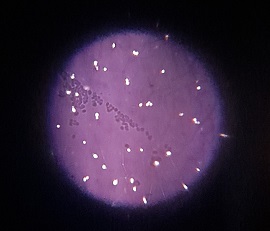
This might look like the night sky through a telescope lens but it isn’t. October has been one of the wettest months of the year so far and torrential rain has been coming down in stair rods for days on end. So, it’s been the ideal week to get out the microscopes and hone my bee- dissecting skills.
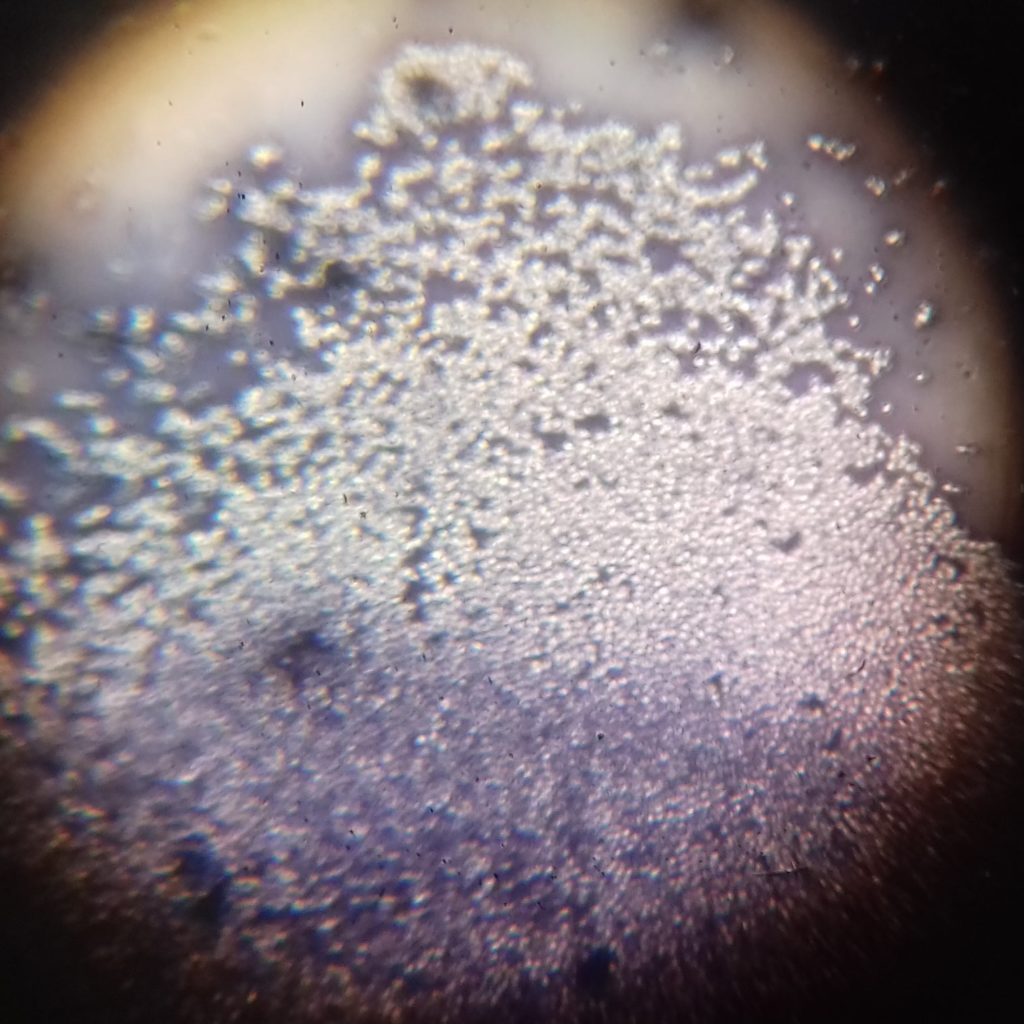
I found chalkbrood stuck in an open mesh hive floor so I crushed it to a powder and made a slide. The colony was a swarm collected in Nairn in June. The photographs show spores that have burst out of the brownish-green fruiting bodies or spore cysts. These cysts look like little round bombs and they burst open releasing trillions of spores. I’ve experimented and stained the specimen with nigrosin (India ink) staining. Nigrosin is usually used for staining bacteria and is called gram negative because the ink has a negative charge as does the bacteria and, since like charges repel, the ink does not penetrate the spores, it only stains the background. Chalkbrood or Acosphaera apis is a fungi not a bacteria but the stain worked well. Perhaps fungus has a negative charge also. The photographs are not perfect as I haven’t quite got the hang of photographing down the microscope with my phone or ordinary camera. Both photographs were taken of the specimen magnified x 400.
Acospahera apis sporulates only when 2 mycelia of the opposite sex come together and do what needs to happen to produce the offspring which are the cysts or ascocarps.
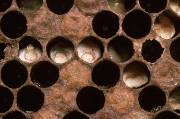
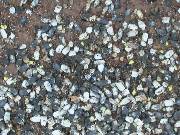
The problem for honey bee larvae is that they are often fed chalkbrood spores with the brood food and they are most vulnerable around day 3-4 of the larval stage. If, when the cell is sealed a couple of days later, the brood chills, the white fungus invades and kills the larvae. It later hardens and you can hear them rattle if you shake a heavily infected brood frame. The spores can remain viable for 15 years in mummified bees, 4 years in the environment and for some time in honey and wax. These are good reasons to change brood comb regularly.
Contributing Factors.
Any situation that causes stress contributes to chalkbrood infections. Cold, dampness, poor ventilation with high carbon dioxide levels and a drop in brood nest temperature are factor to consider. Stress can be caused by poor nutrition and low protein levels, perhaps caused by bad weather and lack of pollen income. Any diseases such as varroa or nosema will weaken a colony and make it more susceptible. Poor beekeeping practices such as making artificial swarms with a decreased worker/brood ratio which causes chilling of brood is a problem. Also, if a nucleus doesn’t have enough nurse bees to keep the brood warm it can easily succumb. Lack of good apiary hygiene and circulating infected brood frames amongst colonies are also factors to consider.
Some strains of honey bee are more hygienic than others and are better able to control the infection. It is worth investing in hygienic bees whenever possible. Some strains are more vulnerable if the queen has been genetically programmed to run the brood nest temperature at lower than normal which is why persistent chalkbrood infections calls for changing the queen. Emergency treatment is to feed the colony and help them raise the brood nest temperature if they are low on stores.
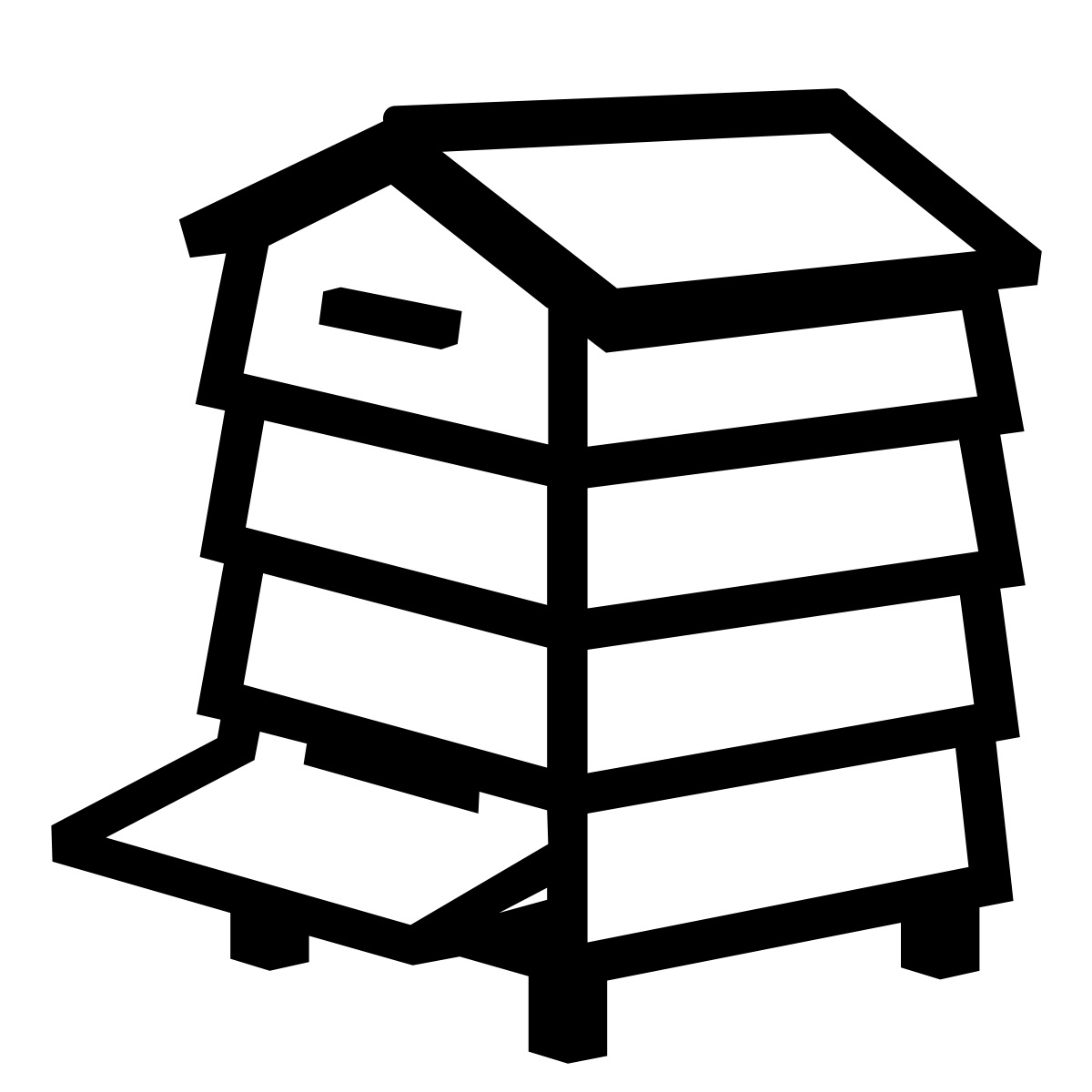

Thank you, Ann. Every beekeeper should read this article.
Thank you, Margaret Anne. Please feel free to share this blog.
Hello Ann. Historically, chalkbrood (Ascosphaera apis) was not present in North America, but in the 1980s chalkbrood infections started to appear in my hives and in those of the Dyce Lab for Honey Bee Studies at Cornell. I and everyone else had no treatment for chalkbrood other than to requeen colonies with bad infections. (We now know that these were colonies that did not maintain the broodnest temperature above 34C. Now one rarely comes across a chalkbrood infection in a colony. This is a good example of natural selection, boosted by artificial/beekeeper selection, solving the problem of the arrival of a novel disease.
That is really interesting, Tom. Thank you for sharing this information.
Great report Ann, what magnification have you used?
Hello Christine. Glad you liked it. Thank you. I used x 400 magnification.